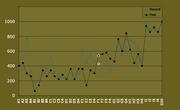|

Torrey Canyon is one of the milestones in the history of oil tanker accidents because all the things that could go wrong did go wrong.
En route from Kuwait to England, it ran aground at the Western entrance to the English Canal. The captain was held responsible for the accident because he had kept the ship on automatic steering at its top speed of nearly sixteen knots. Furthermore, the captain had been advised to change course both by his third officer and by signals from a lightship, but had refused. When he finally decided to change the steering system to manual, it was too late.
The entire cargo, approximately 136 million litres of oil, was released into the sea. English authorities decided to respond prompt and effectively and four hours after the grounding, Royal Navy ships arrived, carrying over 10,000 tons of detergents, which were sprayed on the floating oil to emulsify and disperse it.
Minimal concentrations of these detergents were acutely toxic to many marine mammals and plants and caused a prodigious growth in green weed. The seashores were sprayed with toxic detergents as well.
Efforts to border the ship turned out to be a failure, as one crewmember died during the operation and the ship broke in two.
The following day, it was decided to bomb the ship in order to start fires that would consume the remaining oil. Napalm, kerosene and aviation fuel was dumped on the wreck and for two entire days, the Royal Navy rained 1,000-pound shells on it.
The operations had a devastating effect on environment. An estimated 15,000 birds died, as well as untold numbers of fish and shellfish, and hundreds of kilometres of seashore in both England and France were contaminated.
Comment this page
 
Links and references:
About the ecological consequences:
http://greennature.com/article228.html
Short description of the accident:
http://college.hmco.com/history/readerscomp/ships/...
|

|
|
